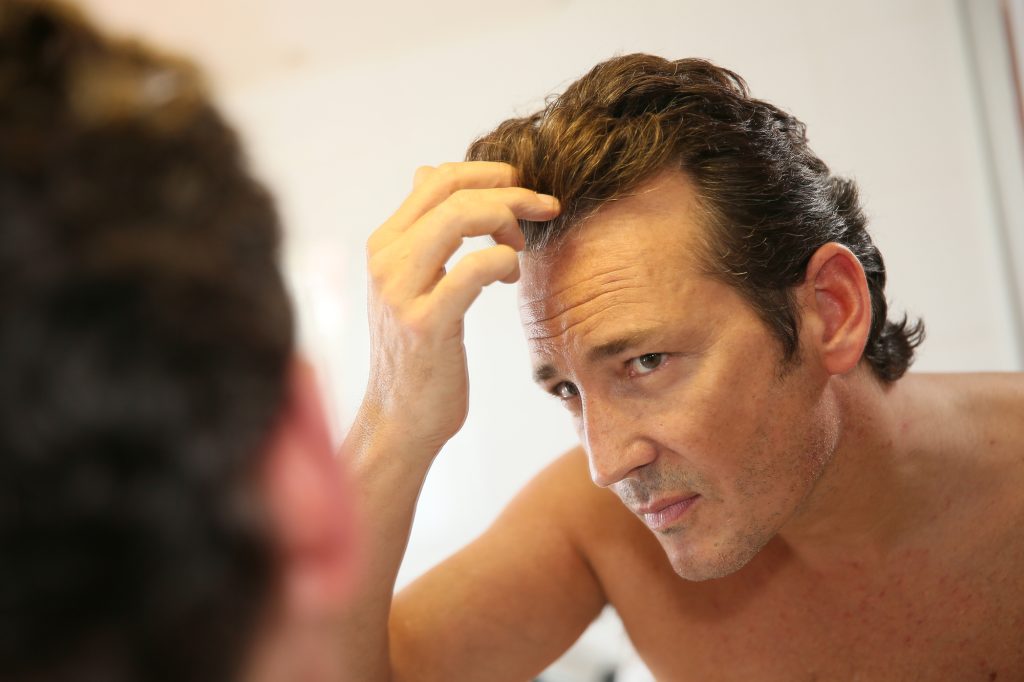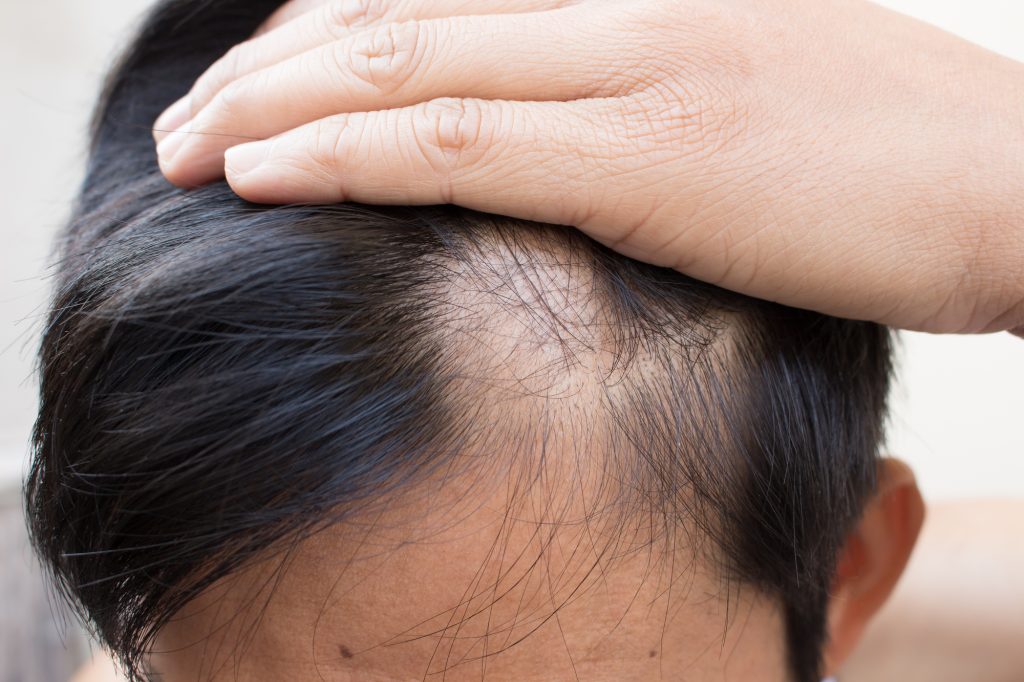
Dihydrotestosterone (DHT) is a hormone that has a role in the development of male pattern baldness. This post will comprehensively cover all aspects of DHT, including its symptoms, preventative methods, and therapies for hair loss caused by DHT and The role of DHT in hair loss.
What is DHT?
Dihydrotestosterone (DHT) is an androgen, which is a male sex hormone, that is synthesised from testosterone by the action of the enzyme 5-alpha reductase. It enhances traditionally masculine traits, such as the growth of body hair, greater muscle mass, and fertility.
As it moves through the bloodstream, it attaches to receptors located on the hair follicles. Some men have hair follicles that are particularly responsive to typical levels of DHT. Through an unidentified process, this triggers the activation of genes that are accountable for the reduction in size of hair follicles, resulting in your scalp becoming less proficient in supporting the growth of healthy hair.
Dihydrotestosterone, being a crucial androgen hormone, can also provide potential hazards to other physiological processes.
What are the Impacts of DHT on the Human Body?
Elevated amounts of dihydrotestosterone (DHT) can heighten your susceptibility to specific ailments, including:
- Prostate cancer
- Benign prostatic hyperplasia
- Delayed dermal regeneration
- Coronary heart disease
Insufficient amounts of dihydrotestosterone present heightened dangers in sexual development, including:
- Gynecomastia, enlargement of breast tissue in males
- Elevated susceptibility to prostate tumours
- Puberty that begins later than expected
The Role of DHT in the Process of Hair Loss
Hair originates from microscopic structures known as follicles, which are distributed throughout the entirety of your body. The average lifespan of hair in a follicle typically ranges from two to six years. Whether you shave or cut your hair, the hair will regrow from the hair follicle.
After completing its cycle, the hair enters a period known as the “resting phase” where it remains for several months until eventually shedding. Subsequently, the root generates fresh hair, initiating the repetition of the cycle.
Androgens can bind to androgen receptors, which are proteins. Binding typically triggers typical hormonal responses, such as the growth of body hair. Nevertheless, certain individuals may possess hair follicles that are particularly vulnerable to the detrimental impact of androgens as a result of genetic polymorphisms in the AR gene.
If your hair follicles exhibit sensitivity to it, DHT has the potential to induce shrinkage and reduction in the duration of this cycle. As your hair develops, it becomes thinner and more fragile, leading to more hair loss. Only a subset of males experience this phenomenon due to variations in their androgen receptor (AR) gene.
What are the Indications of Hair loss Caused by DHT?
The visual characteristics and arrangement of your hair can indicate whether DHT is responsible for your hair loss. The prevailing symptoms include:
- Thinning hair in the front of the scalp
- Hair loss
- Male pattern baldness is characterised by hair loss in the Norwood pattern.
- Fragile hair
The receding hairline is the most conspicuous indicator among all the signs. If you are encountering any of these symptoms, it would be advisable to consider the subsequent preventive measures.
Preventing and Treating Hair Loss Caused by DHT
Fortunately, there are several therapeutic options accessible for hair loss the role of DHT in hair loss. Now, let’s examine the current most popular and efficacious hair loss remedies available in the market.

Serenoa Repens
Saw palmetto is a botanical species whose extract inhibits the enzymatic activity of 5-alpha-reductase. This inhibits the conversion of testosterone into dihydrotestosterone, the hormone responsible for male pattern baldness.
A recent systematic analysis has demonstrated the beneficial effects of consistent saw palmetto intake in individuals with androgenic alopecia. Saw palmetto extract can be obtained in the form of capsules, which are taken as a daily dietary supplement.
Minoxidil is a medication used to treat hair loss. It is commonly sold in commercial packaging as a solution.
Minoxidil is a pharmaceutical compound that widens the blood vessels in the skin. Put simply, it facilitates vasodilation, causing blood vessels to expand and relax, so enhancing the smooth passage of blood (along with essential nutrients) across them.
Historically, the substance was employed for the treatment of hypertension; nevertheless, it was subsequently observed that patients who consumed the medication experienced hair growth. Subsequently, it has been examined as a stimulant for hair growth and is among the two drugs sanctioned by the FDA for treating hair loss.
The efficacy of minoxidil differs among individuals. The reason for this is because minoxidil functions as a pro-drug, undergoing conversion into its active form, minoxidil sulphate, by the action of an enzyme in the scalp known as sulfotransferase.
The activity level of this enzyme varies among individuals, as do the outcomes. The majority of users observe a deceleration in their hair loss, while a portion experience the growth of new hair.
Occasionally, there are individuals known as hyper-responders who might experience a remarkable transformation from complete baldness to a fully covered head of hair in just a few months. However, it is important to note that such cases are extremely uncommon.
Minoxidil
Minoxidil is accessible in the form of a topical solution, foam, and oral tablets. Oral administration of minoxidil may yield improved outcomes, however with a potential escalation in adverse effects, which are generally minor, in contrast to the topical use.
Finasteride is a medication that comes in tablet form and is typically stored in a bottle with an orange backdrop. A medication that inhibits the enzyme 5-alpha reductase. Inhibits the synthesis of dihydrotestosterone (DHT). Three-dimensional rendering
Finasteride is an additional medication that has received approval from the FDA for the treatment of hair loss. Similar to saw palmetto, it functions by inhibiting the conversion of testosterone to dihydrotestosterone.
Regrettably, although it exhibits high efficacy in preventing hair loss, a tiny proportion of individuals (1-3%) may experience unfavourable consequences due to the decrease in DHT levels. These side effects encompass alterations in mood, melancholy, diminished sexual drive, erectile dysfunction, and gynecomastia.
Among a more limited group of men, these adverse effects can endure for an extended period even after discontinuing the medication. The medical community globally is now investigating a condition known as post-finasteride syndrome, which has been discovered recently.
Finasteride
Finasteride should be primarily reserved for cases of severe hair loss and should only be considered after all other viable treatments, such as minoxidil, have been tried without success.
Ketoconazole
Ketoconazole is a pharmaceutical agent utilised for the treatment of fungal infections. However, research has demonstrated its efficacy in addressing hair loss due to its anti-androgenic qualities.
Ketoconazole, minoxidil, and finasteride are commonly referred to as the “big three” and should be used together, if possible, to get the highest level of effectiveness.
There are medicated shampoos containing 2% ketoconazole, which can be quite abrasive to the hair and scalp due to their intended use in treating fungal infections of the scalp.
Nevertheless, an increasing number of shampoos with mild compositions, incorporating ketoconazole, are now available in the market. Therefore, it is advisable to be vigilant and seek out these products, as they have been specifically designed to promote the well-being of both hair and scalp.
Hair Transplant
A hair transplant is a surgical procedure that can effectively address hair loss resulting from dihydrotestosterone. The procedure involves relocating hair from areas of the scalp where it is still growing because to the follicles’ genetic resistance to the detrimental effects of DHT, to areas where hair loss is occurring.
Hair transplants are the most efficacious method for addressing hair loss resulting from male pattern baldness (androgenic alopecia), however individual outcomes may vary among patients.
The Follicular Unit Extraction (FUE) technique is now leading the way among the numerous types of hair transplant treatments. The hair transplants are taken individually, allowing for the recreation of your hairline and ensuring a smooth outcome.
Prior to making a decision, it is advisable to consult with your physician regarding the advantages and disadvantages of undergoing a hair transplant procedure. If you are interested in discussing the possibility of undergoing a hair transplant procedure with one of our specialists, we invite you to schedule a complimentary appointment with us.
Conclusion
Dihydrotestosterone (DHT) plays a pivotal role in the development of male pattern hair loss and exerts influence on various other physiological processes. Multiple therapeutic options are accessible to tackle this matter, and a comprehensive approach to hair maintenance is also essential.
In this post, we covered the role of DHT in hair Loss. Adhering to low-maintenance regimens, such as including dietary supplements, can significantly contribute to the reversal of hair loss and restore your sense of identity. In the event of all other attempts becoming unsuccessful, you might opt for a cost-effective hair transplantation procedure in Turkey to regain their hair’s previous magnificence. Get a free consultation from our experienced doctors to learn more about hair transplants.
References:
https://www.medicalnewstoday.com/articles/68082#What-is-DHT?

